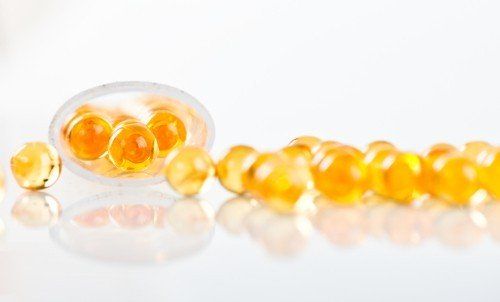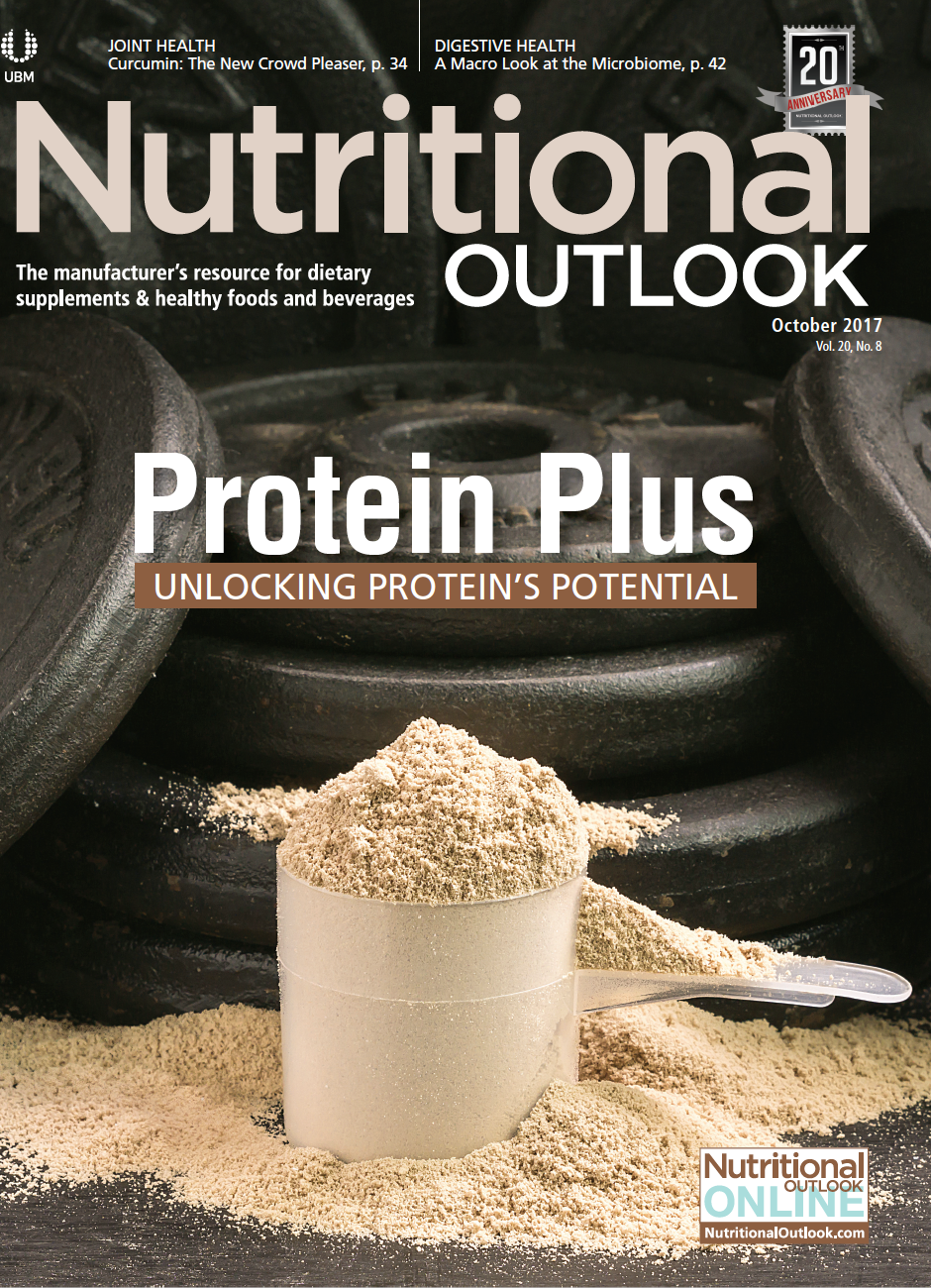Vitamin E: A Closer Look at Tocotrienols
An expanding body of research points to the significant benefits of tocotrienols.
Photo © Shutterstock.com/Valeri Potapova

By Barrie Tan, PhD, American River Nutrition
Researchers estimate that the human body could contain as many as 75 trillion cells. Each of those cells is surrounded by a bean-shaped membrane made up of dense rows of fatty acids that require protection from lipid peroxidation. Of the many popular antioxidants that help protect cells (e.g., astaxanthin, lutein, lycopene, CoQ10), vitamin E is the one nature chose to reside within the lipid cell membrane to protect its integrity. Vitamin E comes in the perfect molecular shape to do this job-like a tadpole, with a head and tail, similar to the phospholipids that complement the cell membrane. Vitamin E is distinguished by a chromanol head with a lipid-soluble side chain.
There are two forms of vitamin E: tocotrienols and tocopherols. Not all forms of vitamin E are the same, however. Tocopherols have a longer tail (phytyl), whereas tocotrienols have a shorter, more flexible tail (farnesyl).1 This small difference in molecular structure allows tocotrienols to cover a larger surface area of the cell membrane more quickly, hence making them more effective as antioxidants. As this article will discuss, an expanding body of research points to significant benefits supporting the tocotrienol form.
Tocotrienols vs. Tocopherols
When vitamin E was discovered in 1922, it was discovered as alpha-tocopherol. Between that time and 1940, scientists delved into tocopherol research, ranging from alpha-tocopherol’s isolation from plants2, chemical identification3,4, complete synthesis5, and antioxidant activity6. In fact, the tocopherol form remained the main focus of vitamin E science for decades, and, as such, research on tocopherols boomed.7,8
Tocotrienols were discovered later, in the mid-1960s.9,10 Tocotrienols’ ability to lower lipids was first reported in the early 1980s; in the 1990s, tocotrienols were associated with reduction of cardiovascular diseases and inhibition of cancers.11 Despite the growing research on tocotrienols, they are still often confused with tocopherols and were not even properly listed in the Merck Index, the encyclopedia of chemicals, drugs, and biologicals, until 2001.12
Lingering confusion over the difference between tocotrienols and tocopherols is understandable, considering that both have the same chromanol head. Today, alpha-tocopherol remains the most common vitamin E source on the market despite some lingering debate around it.
Debate around Tocopherols
Commercialization of natural, soy-derived tocopherols began in the 1950s; however, high demand for tocopherols prompted many companies to eventually switch from soy- and corn-derived tocopherols (whose crops typically yielded less than 20% alpha-tocopherol) to 100% alpha-tocopherol. Today, much of the “natural” alpha-tocopherol on the market is in fact semi-synthetic, with soy- and corn-based tocopherols synthesized to (RRR- or d-) alpha-tocopherol via the addition of one methyl group to gamma-tocopherol and two methyl groups to delta-tocopherol.13
While synthetic tocopherol ingredients do exist in the market, synthetic tocotrienol ingredients do not. Tocotrienols are still sourced from a wide array of foods, including wheat, barley, and corn. Rice, palm, and annatto are the richest tocotrienol sources.
Some research suggests that alpha-tocopherol interferes with the helpful activity of tocotrienols. Following an animal study published in the Journal of Nutrition in 199614, researchers suggested that tocotrienols were more potent hypocholesterolemic agents when administered with the lowest alpha-tocopherol content possible. In the study, chickens were fed either an alpha-tocopherol control diet or alpha-tocopherol administered in combination with gamma-tocotrienol. The group with the largest-supplemented amount of alpha-tocopherol showed increased activity of the rate-limiting enzyme responsible for cholesterol production, 3-hydroxy-3-methyl-glutaryl-CoA reductase (HMGR), and as a result cholesterol levels rose in that group-prompting researchers to conclude that in order for tocotrienols to help lower cholesterol, alpha-tocopherol content should not be more than 15%.
Four years later, another study in guinea pigs reported similar findings in favor of tocotrienols compared to tocopherols.15 In this study, researchers found that alpha-tocopherol, when co-administered with tocotrienols, reduced tocotrienols’ inhibitory effect on HMGR. When administered alone, tocotrienols reduced the enzyme’s activity by 48%; however, adding alpha-tocopherol meant that the combination inhibited HMGR by only 13%. Fast-forward through 15 years of clinical studies: tocopherol-tocotrienol mixtures did little or nothing to lower lipids, but when tocopherols were removed from the mixtures, lipids would decrease.16, 17
Additional research suggests that tocopherols may be a monkey-wrench to tocotrienol functions. One small 2009 prospective study indicated that tocopherols may interfere with breast cancer medication18, while a 2015 animal study19 found that excessive amounts of alpha-tocopherol may worsen stroke-related brain injuries. In 2005, those same researchers found that while orally supplemented alpha-tocotrienol was shown to reach most tissues and vital organs (including the skin, adipose tissue, ovaries, heart, liver, central nervous system, spinal cord, brain, lung, testes, and skeletal muscle), the mechanisms for transporting alpha-tocopherol and alpha-tocotrienol apparently compete, leading the researchers to note that “the transport efficiency of alpha-tocotrienol to tissues may be maximized by eliminating the co-presence of alpha-tocopherol in the oral supplement.”20
The reasoning behind this can be readily understood. Of all eight isomers of vitamin E, only alpha-tocopherol has a known transport protein-a protein chaperone that provides a rite of passage-that recognizes alpha-tocopherol alone of all the eight isomers and delivers it to the tissues of interest. Then, by passive diffusion and emulsification with fats in a meal, all other vitamin E isomers get absorbed, like most lipid-soluble nutrients. Thus, co-supplementation with alpha-tocopherol is likely to compromise tissue delivery of alpha-tocotrienol.21 Alpha-tocopherol administration has also been found to decrease the gamma-tocotrienol concentration in the adipose tissue and skin, inhibiting both alpha-tocotrienol and gamma-tocotrienol tissue uptake.22
Tocotrienols’ Time to Shine
While alpha-tocopherol research still occurs at a much greater level than tocotrienol research, there has been a downward trend in alpha-tocopherol research alongside an increase in understanding of tocotrienols driven by a growing body of science. Furthermore, FDA’s impending changes to the U.S. Nutrition Facts label, which include changing the unit of measure for vitamin E from IU to mg, will further underscore the differences between the two forms. Under the new labeling standard, 1 mg of natural vitamin E (RRR-alpha-tocopherol) equals 1 mg of vitamin E, but 2 mg of synthetic vitamin E (all-rac-alpha-tocopherol) equates to only 1 mg of natural vitamin E. The reason? In a nutshell: when synthesizing alpha-tocopherol, the stereochemistry changes that occur result in molecules that are not identical to natural alpha-tocopherol, although they may still be of the same molecular weight.
Growing consumer demands for natural sources of vitamin E, coupled with promising research in several important health categories, should fuel more interest in tocotrienols. Below are just a few study areas of interest showing positive results.
Editor’s note: Asterisks indicate studies performed by the author’s company, American River Nutrition (Hadley, MA), or on the company’s DeltaGold annatto tocotrienol ingredient. Some studies were also funded by American River Nutrition.
Cardiovascular Health
Thirty-one subjects with high cholesterol took escalating doses of tocotrienols-125, 250, 500, and 750 mg/day of American River Nutrition’s DeltaGold annatto tocotrienol-for four weeks each, with a two-week wash-out period between each dose. Researchers concluded that total cholesterol fell by 15%, while LDL cholesterol was reduced by 18%. Other notable outcomes: triglycerides decreased by 14%, and the cytokines associated with cardiovascular disease decreased by as much as 64%.17 *
Anti-Inflammation
The same parameters were employed to examine DeltaGold annatto tocotrienols’ effect on inflammatory markers, with equally impressive results. (Note: In this study and the one previously profiled, 250 mg/day was identified as an optimal dose of tocotrienols.) Among the promising results: C-reactive protein levels (a predictor of chronic inflammation) were reduced by 40%, and nitric oxide levels, which are aberrant in inflammatory conditions and should be reduced (only in inflammatory conditions), were also lowered by 40% in subjects.23 *
Two clinical studies indicate that delta-tocotrienol, combined with antioxidant polyphenols, may curb inflammation and help manage dyslipidemia (the elevation of plasma cholesterol), triglycerides, or both, or help to lower high-density lipoprotein levels that contribute to the development of atherosclerosis.24,25 * One placebo-controlled study was conducted in two groups of elderly subjects over six weeks, one with normal lipid levels, the other elevated. The product formulation was composed of DeltaGold delta-tocotrienol from annatto along with a B-vitamin (niacin) and polyphenols. In both groups, supplementation led to a significant drop in C-reactive protein and -glutamyl-transferase (a predictor of non-fatal myocardial infarction and fatal coronary heart disease), while increasing total antioxidant status. In the hypercholesterolemic group, the following also dropped: LDL cholesterol (by 20%-28%) and triglycerides (by 11%-18%). C-reactive protein dropped in healthy elderly subjects (by 21%-29%) and in the hypercholesterolemic elderly (by 31%-48%). No adverse effects were observed.
Bone Health
In a 2017 in vivo study involving 48 female Sprague-Dawley rats, DeltaGold tocotrienol from annatto-with or without lovastatin-increased bone formation and mineralization in rats. Researchers concluded that “supplementation of tocotrienol in statin users can potentially protect them from osteoporosis.”26 *
Our company is also embarking on (and sponsoring) a study of DeltaGold tocotrienols’ effect on the bone health of 89 postmenopausal women on tocopherol-free tocotrienol. This study will hopefully provide welcome clarity on how the nutrient affects human subjects. The study should be published in late 2017. As of this writing, early results look very promising.
Bioavailability
Tocotrienols’ bioavailability has been questioned in the past, resulting in the marketing of bio-enhanced, synthetic emulsions that are said to increase absorption. The solution for increasing tocotrienols’ bioavailability is easy, however, and time-tested: take tocotrienols with a meal.
Two studies27,28 on DeltaGold confirmed the bioavailability of tocopherol-free annatto tocotrienol. An open-label randomized trial involved 125, 250, 500, 750, and 1000 mg/day dosage groups. Many pharmacokinetic parameters were studied in healthy subjects to ascertain that delta- and gamma-tocotrienol were absorbed. When taken with a meal, both tocotrienols were absorbed and bioavailable.*
The Future for Tocotrienols
Research clearly shows that not all vitamin E isomers are the same. Tocotrienols have well-differentiated functions from tocopherols, with a growing body of evidence supporting its benefits for chronic conditions. Considering that studies show that tocopherol does not augment the function of tocotrienol, but rather antagonizes it, in my professional opinion, in order to fully appreciate the benefits of tocotrienol, manufacturers should formulate with delta- and gamma-tocotrienols, without tocopherol or with the lowest amount of alpha-tocopherol possible.
Barrie Tan, PhD, a foremost vitamin E expert, is credited with identifying the primary sources of plant-based tocotrienols. Today, his research focuses on nutrients that impact aging conditions. Tan is the senior editor of Tocotrienols: Vitamin E Beyond Tocopherols (2013), and collaborates with universities worldwide to further tocotrienol research.
Also read:
Tocotrienols May Promote Bone Health in Postmenopausal Osteopenic Women in New Study
Tocotrienol Regulates Gastric Growth Factors Better than Omeprazole in Animal Study
References:
- Sen C et al., “Tocotrienols: Vitamin E beyond tocopherols,” Life Sciences, vol. 78, no. 18 (March 27, 2006): 2088-2098
- Evans HM et al., “The isolation from wheat germ oil of an alcohol alpha-tocopherol, having the properties of vitamin E,” The Journal of Biological Chemistry, vol. 113, no. 1 (February 1936): 319-332
- Fernholz E, “The thermal decomposition of alpha-tocopherol,” Journal of the American Chemical Society, vol. 59, no. 6 (July 1937): 1154-1155
- Fernholz E, “On the constitution of alpha-tocopherol,” Journal of the American Chemical Society, vol. 60, no. 3 (March 1938): 700-705
- Karrer P et al., “Synthese des alpha-tocopherol,” Hevetica Chimica Acta, vol. 21 (1938): 820-825
- Olcott HS et al., “Antioxidant and autoxidation of fats: the antioxidant properties of tocopherols,” Journal of the American Chemical Society, vol. 59, no. 6 (June 1937): 1008-1009
- Emerson OH et al., “The chemistry of vitamin E: tocopherols from various sources,” Journal of Biological Chemistry, vol. 122, no. 1 (December 1937): 99-107
- Stern MH et al., “Delta-tocopherol; isolation from soybean oil and properties,” Journal of the American Chemical Society, vol. 69, no. 4 (April 1947): 869-874
- Pennock JF et al., “Reassessment of tocopherol in chemistry,” Biochemical and Biophysical Research Communications, vol. 17, no. 5 (November 30, 1964): 542-548
- Whittle KJ et al., “The isolation and properties of delta-tocotrienol from Hevea latex,” The Biochemical Journal, vol. 100, no. 1 (July 1966): 138-145
- Sylvester P et al., “Role of tocotrienols in the prevention of cardiovascular disease and breast cancer,” Current Topics in Nutraceutical Research, vol. 1, no. 2 (May 2003): 121-136
- Merck Index 13th ed. Tocols: 9570-9577. Rahway, NJ. Merck Publishing Group; 2001: 1693-1694
- Tan B, “Appropriate spectrum vitamin E and new perspectives on desmethyl tocopherols and tocotrienols,” Journal of the American Nutraceutical Association, vol. 8, no. 1 (2005): 35-42
- Qureshi AA et al., “Tocopherol attenuates the impact of gamma-tocotrienol on HMG-CoA reductase activity in chickens,” Journal of Nutrition, vol. 126, no. 2 (February 1996): 389-394
- Khor HT et al., “Effects of administration of alpha-tocopherol and tocotrienols on serum lipids and liver HMG CoA reductase activity,” International Journal of Food Sciences and Nutrition, vol. 51, suppl. 1 (2000): S3-S11
- Heng KS et al., “Potential of mixed tocotrienol supplementation to reduce cholesterol and cytokine levels in adults with metabolic syndrome,” Malaysian Journal of Nutrition, vol. 21, no. 2 (2015): 231-243
- Qureshi AA et al., “Dose-dependent modulation of lipid parameters, cytokines and RNA by delta-tocotrienols in hypercholesterolemic subjects restricted to AHA step-1 diet,” British Journal of Medicine & Medical Research, vol. 6, no. 4 (2015): 351-366
- Peralta EA et al., “Vitamin E increases biomarkers of estrogen stimulation when taken with Tamoxifen,” The Journal of Surgical Research, vol. 153, no. 1 (May 2009): 143-147
- Khanna S et al., “Excessive -tocopherol exacerbates microglial activation and brain injury caused by acute ischemic stroke,” The FASEB Journal, vol. 29, no. 3 (March 2015): 828-836
- Khanna S et al., “Delivery of orally supplemented alpha-tocotrienol to vital organs of rats and tocopherol-transport protein deficient mice,” Free Radical Biology & Medicine, vol. 39, no. 10 (November 15, 2005): 1310–1319
- Trias AM, Tan B. Alpha-Tocopherol: A Detriment to Tocotrienol Benefits. In: Tocotrienols: Vitamin E Beyond Tocopherols, 2nd ed. Tan B, Watson R, Preedy V, editors. Boca Raton, FL: CRC Press; 2013: 61-78
- Ikeda S, Uchida T, Abe C. Bioavailability of Tocotrienols and Interference of Their Bioavailability by Alpha-Tocopherol Supplementation. In: Tocotrienols: Vitamin E Beyond Tocopherols, 2nd ed. Tan B, Watson R, Preedy V, editors. Boca Raton, FL: CRC Press; 2013: 53-60
- Qureshi AA et al., “Impact of -tocotrienol on inflammatory biomarkers and oxidative stress in hypercholesterolemic subjects,” Journal of Clinical & Experimental Cardiology. Published online April 25, 2015.
- Qureshi AA et al., “Suppression of nitric oxide production and cardiovascular risk factors in healthy seniors and hypercholesterolemic subjects by a combination of polyphenols and vitamins,” Journal of Clinical & Experimental Cardiology. Published online June 7, 2012.
- Qureshi AA et al., “Nutritional supplement-5 with a combination of proteasome inhibitors (resveratrol, quercetin, -tocotrienol) modulate age-associated biomarkers and cardiovascular lipid parameters in human subjects,” Journal of Clinical & Experimental Cardiology. Published online March 2, 2013.
- Chin KY et al., “The effects of tocotrienol and Lovastatin co-supplementation on bone dynamic histomorphometry and bone morphogenetic protein-2 expression in rats with estrogen deficiency,” Nutrients. Published online February 15, 2017.
- Qureshi AA et al., “Pharmacokinetics and bioavailability of annatto -tocotrienol in healthy fed subjects,” Journal of Clinical & Experimental Cardiology. Published online November 30, 2015.
- Qureshi AA et al., “Evaluation of pharmacokinetics, and bioavailability of higher doses of tocotrienols in healthy fed humans,” Journal of Clinical & Experimental Cardiology. Published online April 28, 2016.
























